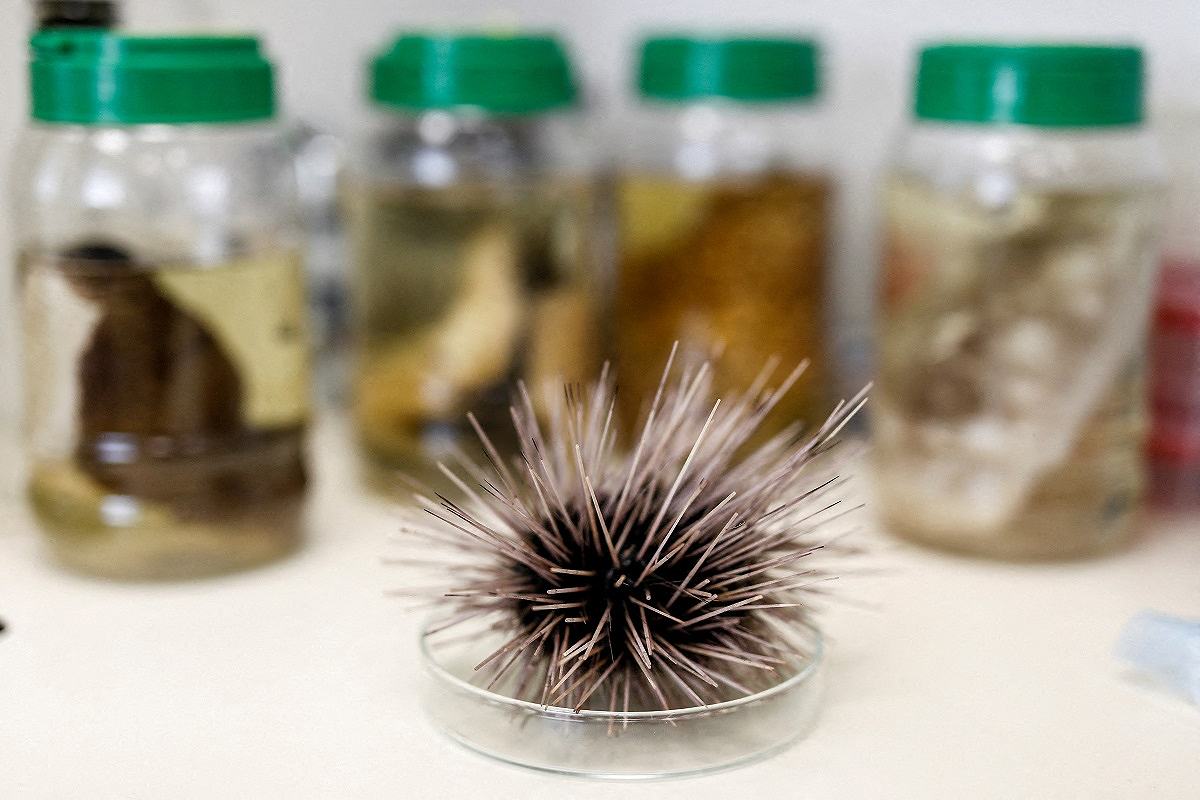
A dead black sea urchin is seen at a laboratory in Tel Aviv University’s Steinhardt Museum of Natural History, Israel, in May 2023.
13:16 JST, June 29, 2024
TEL AVIV (Reuters) — A sea-borne pandemic that wiped out sea urchin populations in the Red Sea has spread and is taking out the species in parts of the Indian Ocean and could go global, scientists in Israel say.
The particular species of sea urchin impacted is a well-known protector of coral reefs and the deaths put the already fragile reef ecosystem in even more peril.
The pandemic was first noticed in the Gulf of Aqaba a year ago and researchers say they have since identified the pathogen behind it through molecular analysis. They are linking it to mass deaths across the Red Sea, the Arabian peninsula and as far as Reunion Island off Madagascar.
The pathogen kills fast and violently — in just two days colonies can be lost — making it hard to assess how many are dying, said Omri Bronstein, a zoologist from Tel Aviv University and the Steinhardt Museum of Natural History.
It seems to be heading east toward the tropical waters of the Coral Triangle that extends off southeast Asia and Australia’s Great Barrier Reef.
“I fear that, at the current situation, this is the trajectory, so this is where it’s going,” he said.
Their findings were published in the journal Current Biology.
‘Lawn mowers’
Bronstein described the affected sea urchin species as the “lawn mowers” of coral reefs, since they remove algae that otherwise blocks sunlight, allowing the coral to thrive.
In the Gulf of Aqaba, no other creature has taken over that role and Bronstein’s team is already seeing extensive growth in algae cover.
“When mortalities started in the Red Sea, they were so strong and so abrupt and so violent that the first thoughts were this must be some kind of pollution, or something very severe but very local,” he said.
Then the phenomenon was seen at a wharf farther south in Sinai where a ferry from Aqaba docks. Two weeks later it spread another 70 kilometers. They described thousands of skeletons of the once dominant species rolling on the sea bottom.
There is no known way to stop the disease, Bronstein said. But there is still a chance to create an isolated population, or broodstock, of the sea urchins remaining elsewhere that could hopefully be reintroduced later on.
The Israeli team is now cooperating with scientists across the region to map the pandemic and gather more details. This includes collecting continuous samples of environmental DNA from the different bodies of water that show how sea life interacts with the surroundings.
“You must have people on site to provide you with data, because within 48 hours you have no evidence of the mortalities even taking place,” Bronstein said. “This coordination and this collaboration is one of the keys of being able to be on top of this rapidly evolving situation.”
"Science & Nature" POPULAR ARTICLE
-

Genome Study Reveals Milestone in History of Cat Domestication
-

Big Leap in Quest to Get to Bottom of Climate Ice Mystery
-

Security Camera Footage Vulnerable to Outside Access; Investigation Finds 3,000 Pieces Exposed Online
-

Paws on Parade: Nairobi’s Dogs Dazzle at ‘Pawchella’
-

Japan Set to Participate in EU’s R&D Framework, Aims to Boost Cooperation in Tech, Energy
JN ACCESS RANKING
-

Keidanren Chairman Yoshinobu Tsutsui Visits Kashiwazaki-Kariwa Nuclear Power Plant; Inspects New Emergency Safety System
-

Imports of Rare Earths from China Facing Delays, May Be Caused by Deterioration of Japan-China Relations
-

Tokyo Economic Security Forum to Hold Inaugural Meeting Amid Tense Global Environment
-

University of Tokyo Professor Discusses Japanese Economic Security in Interview Ahead of Forum
-

Japan Pulls out of Vietnam Nuclear Project, Complicating Hanoi’s Power Plans

























